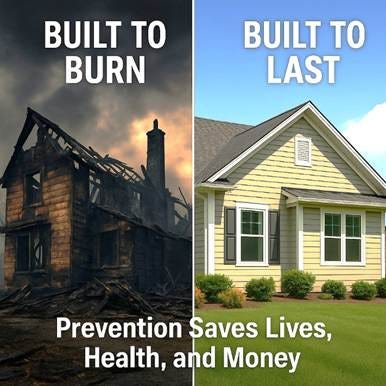Built to Burn or Built to Last
How proactive design and policies avert tragedy, protect health, and save lives
On June 14, 2017, residents of London’s Grenfell Tower woke to flames racing skyward, fueled by flammable cladding (the outer layer applied to a building's exterior to protect the structure from wind, rain, and sunlight). By dawn, 72 lives had been lost due to several causes, including fire doors not sealing and closing, absent sprinkler systems, and ignored safety recommendations. It was Britain’s deadliest blaze in a residential building since World War II.
In January 2025, wildfire embers, propelled by powerful Santa Ana winds, rained down on homes in Pacific Palisades and Altadena, California. While many houses burned, others survived, protected by hardened roofs, tempered windows, and defensible space.
These were two tragedies wherein, had prevention been prioritized, lives would have been spared, and severe injuries, long-term health issues, and immense financial losses could have been avoided.
Urban Fire Safety: Lessons from Grenfell
On the day following the fire, British Prime Minister Theresa May ordered a public inquiry into the Grenfell Tower Fire. The Inquiry published its second and final report on September 4, 2024, which detailed how a chain of failures across government and the private sector led to this disaster. The review led to some significant changes, including the introduction of the Building Safety Act, ensuring greater accountability among construction professionals.
After Grenfell, the UK government banned combustible cladding, but broader reforms, such as universal sprinklers and robust inspections, remain largely unimplemented. The cladding crisis continues to impact lives almost eight years later, with thousands of buildings in the UK affected. By 2024, only about half of London’s 4600 poorly clad high-rises had started or completed necessary remediation, leaving many still vulnerable. Inaction has meant that many of the conditions that allowed Grenfell to happen still exist.
The financial cost of the Grenfell Tower catastrophe has approached £1.2 billion (about $1.6 billion), which was nearly 4,000 times the savings achieved from substituting fire-retardant cladding with a less expensive option during the Grenfell Tower construction. Most of the cost was paid from public funds.
Wildfire Safety: Lessons from Los Angeles
The fires in Los Angeles took 31 lives, but researchers have found that 440 more deaths could have been attributed to the disaster. A study, recently published in JAMA, analyzed data from January 5 to February 1, 2025, during the LA fires. These additional deaths likely resulted from factors such as poor air quality, toxic substances in wildfire smoke, and delays in access to healthcare. The fatalities also highlight the need for improved mortality surveillance during and after wildfire emergencies.
Insured losses from January’s LA wildfires could reach $45 billion, according to researchers at the University of California at Los Angeles. However, there is a huge disparity between the cost of prevention measures and that of a catastrophic wildfire. Removing vegetation, wood gates, and other combustible material within five feet of a home to create an ember-resistant zone is one of the most effective ways to avert an urban firestorm. California in 2020 had enacted a law that mandated the establishment of such protections, called Zone Zero, in wildfire-vulnerable communities. Homeowners complained about the potential cost of complying with Zone Zero, noting that it would be extremely expensive and unaffordable. One estimate notes that it would have cost exposed homeowners nearly $58 million to comply with these proposed regulations.
California's efforts to implement ember-resistant zones, mandated by the 2020 law, have faced significant delays. The California Board of Forestry and Fire Protection has struggled to finalize regulations due to pushback from insurance lobbyists, fire officials, and homeowners concerned about costs and aesthetic changes. Investigators have indicated that the absence of these regulations contributed to the destruction of homes and the loss of lives. While many houses burned swiftly, others, newly built or retrofitted according to the state’s 2020 wildfire-resistant standards, withstood flames entirely. These facts highlight a disconnect between the urgency of climate threats and the political and social challenges of implementing effective wildfire prevention measures.
Benjamin Franklin’s Fire Prevention Advice
Benjamin Franklin understood the critical importance of proactive fire prevention nearly 300 years ago. In a 1735 letter published anonymously in the Pennsylvania Gazette, Franklin advocated for simple preventive steps, including properly swept chimneys, safe heating methods, and community firefighting brigades. His call to action was clear: “An ounce of prevention is worth a pound of cure.”
Franklin didn’t stop at words. In 1736, he founded America’s first volunteer firefighting brigade, the Union Fire Company of Philadelphia, pioneering organized, preventive community firefighting. His work showed that anticipating danger and taking proactive steps is not just a sensible policy. It is the difference between life and death, between safety and suffering, between economic stability and ruin.
Housing is healthcare. But homes need to be affordable and safe. From the tragedy of Grenfell Tower to the survival of homes in Los Angeles, the evidence is clear. Fire safety is not a luxury but a necessity.



